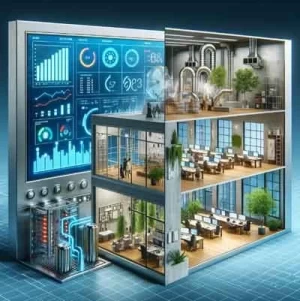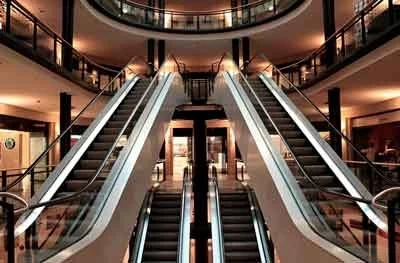Optimizing User Behavior for BAS-Driven Energy Management

Building Automation Systems (BAS) offer a powerful tool for optimizing energy consumption in buildings. However, achieving maximum energy savings often hinges on a factor beyond the control of BAS systems themselves: occupant behavior. This article explores the challenges associated with occupant behavior impacting energy management goals and delves into strategies for promoting user engagement in energy-efficient practices within BAS environments. The role of user interfaces (UIs) and feedback mechanisms will be examined as crucial tools for influencing occupant behavior and achieving optimal energy savings.
Visit Our Building Automation Study Course
The Human Factor: A Challenge to Efficiency
Even the most sophisticated BAS can struggle to achieve maximum energy savings if occupant behavior remains unaddressed. Here are some common examples of occupant actions that can counteract BAS optimization efforts:
Manual Overrides: Occupants may override BAS settings for temperature, lighting, or ventilation, prioritizing comfort over energy efficiency. For example, adjusting thermostats beyond recommended settings or leaving lights on in unoccupied spaces.
Lack of Awareness: Occupants may be unaware of the energy implications of their actions or the impact their behavior has on overall building energy consumption.
Inconvenient Controls: Complicated or poorly designed user interfaces can lead to frustration and discourage occupants from engaging with BAS features for energy-saving adjustments.
Bridging the Gap: Strategies for User Engagement
Strategies can be implemented to encourage occupants to actively participate in energy-saving practices alongside BAS functionality:
Education and Awareness Campaigns: Engaging educational campaigns can inform occupants about the impact of their behavior on building energy consumption. This can raise awareness about the benefits of energy efficiency for both environmental and financial reasons.
Gamification and Incentives: Gamification elements can be incorporated into BAS user interfaces, encouraging occupants to compete with colleagues or against building-wide benchmarks for energy efficiency. Points or rewards can be offered to motivate participation in energy-saving practices.
Real-time Feedback and Visualization Tools: BAS can be integrated with user-friendly dashboards or mobile apps providing real-time feedback on energy consumption. Visualizing energy use can empower occupants to see the immediate impact of their actions and encourage them to adopt energy-saving behaviors.
Personalized User Controls: Providing occupants with a degree of personalized control over certain building conditions, especially within individual workspaces, can foster a sense of ownership and encourage engagement with BAS functionality. This can involve offering adjustable thermostat settings within a designated range or allowing for personalized lighting preferences within pre-defined parameters to balance comfort with energy savings.
The Power of Information: User Interfaces and Feedback Mechanisms
The design and functionality of user interfaces (UIs) and feedback mechanisms within BAS play a critical role in influencing occupant behavior:
User-Friendly Interfaces: BAS UIs should be intuitive and easy to navigate, minimizing the learning curve and encouraging occupant interaction. Clear labeling, simple controls, and visual aids can all contribute to a user-friendly experience.
Actionable Feedback: Feedback mechanisms should provide occupants with clear and actionable information about energy consumption and the impact of their actions. Real-time data visualization tools that showcase energy use patterns and comparisons against benchmarks can empower occupants to make informed choices that contribute to energy efficiency.
Personalized Feedback: Where possible, feedback mechanisms can be personalized to provide occupants with data relevant to their specific workspaces or actions. This personalized approach can increase the relevance and impact of feedback, fostering a stronger connection between occupant behavior and energy consumption.
Integrated Communication Channels: Integrating BAS feedback mechanisms with mobile apps or building-wide communication channels can provide a convenient way to reach occupants and deliver personalized messages promoting energy-saving behaviors.
Beyond the Interface: Building a Culture of Efficiency
The success of user engagement strategies goes beyond the technical aspects of BAS interfaces and feedback mechanisms. Building a culture of energy efficiency within an organization plays a crucial role:
Leadership Support: Strong leadership support for energy-saving initiatives sends a clear message to occupants about the importance of energy conservation. Leaders can champion BAS functionality and promote user engagement strategies.
Employee Recognition: Recognizing and celebrating employee achievements in contributing to energy savings can further motivate engagement and create a positive cultural shift towards energy efficiency.
Open Communication and Collaboration: Encouraging open communication between building management and occupants fosters a sense of shared responsibility for energy consumption. Collaboratively establishing energy-saving goals and tracking progress can reinforce positive behaviors.
The Human Factor: A Key to Sustainability
Unlock the Full Potential of BAS: Optimizing user behavior alongside BAS functionality allows for a holistic approach to energy management. This collaborative effort leads to maximized energy savings, a more sustainable building environment, and a reduction in the building's carbon footprint.
Conclusion: Building a Bridge Between People and Technology
Building Automation Systems offer a powerful tool for energy management, but their full potential can only be realized by acknowledging the human factor. By implementing strategies to encourage user engagement, providing user-friendly BAS interfaces with actionable feedback mechanisms, and fostering a culture of energy efficiency within an organization, stakeholders can build a bridge between people and technology. This collaborative approach paves the way for buildings that are not only energy-efficient but also encourage occupant comfort and environmental responsibility, creating a foundation for a more sustainable future.









